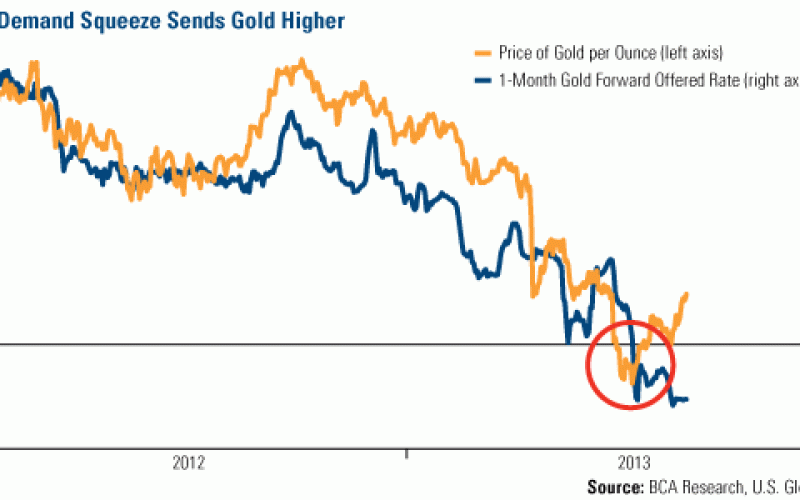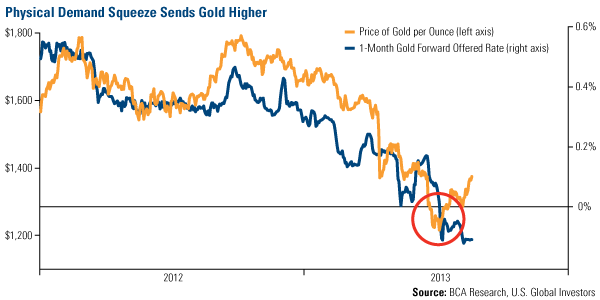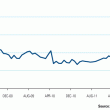Gold Market Radar (August 26, 2013)
For the week, spot gold closed at $1,397.52, up $20.65 per ounce, or 1.50 percent. Gold stocks, as measured by the NYSE Arca Gold Miners Index, rose 1.16 percent. The U.S. Trade-Weighted Dollar Index rose 0.15 percent for the week.
Strengths
- Gold holdings in the world’s largest gold ETF rose 4.2 tons last week, marking a strong trend reversal from the first half of the year, as gold's recent positive momentum attracts investors. Meanwhile, jewelry demand in Indonesia, the world’s fourth most populous nation, is set to expand to a four-year high as consumers in Southeast Asia’s biggest bullion buyer join India and China in increasing purchases. Bloomberg reports that the consumption of necklaces, bracelets and rings will probably climb to 40 metric tons this year, a 30 percent increase from 30.8 tons in 2012.
- Total gold available for delivery at COMEX is holding at record-low levels, according to Dundee Capital. Since August 1, the registered gold in the COMEX warehouse has declined by nearly 150,000 ounces to a new low of 791,000 ounces. Deliverable gold is now down 65 percent year-to-date. Bullion banks are likely struggling to deliver physical gold as we head into the peak seasonal demand for the metal. Perhaps this is why the one-month Gold Forward Offered Rate (GOFO) has been negative for 35 consecutive days, along with the negative six-month GOFO.
- In preparation for an expected $15 billion in foreign direct investment in mining projects in Peru over the next two years, the country’s Ministry of Energy and Mines is working to slash the timetable for new exploration permits to less than 200 days, looking to establish the fastest exploration permitting schedule in Latin America. Previously, the permits took between 300 to 500 days. The Minister observed that mining generates about 30 percent of Peru’s national budget and that nearly 10 million Peruvians are linked either directly or indirectly to mining. We believe government policies are a precursor to change, and it looks as though Peru’s pragmatic government is setting up for near term success.
Weaknesses
- Stifel Nicolaus announced its decision to close its Toronto and Calgary operations, effective Friday August 23. Stifel seems to have one of the better gold and precious metals research teams in the industry, and the decision from the executive office to close its operation on the back of two quarters of weak gold interest, could be seen as a signal of the last capitulation stages. We have previously noted how bullish these late-stage capitulation moves can be for a sector, especially for contrarian investors.
- Gold Fields Ltd announced the reaching of an agreement with Barrick Gold Corp. to acquire its interests in the Yilgarn South Assets in Western Australia. However, during the company’s second quarter earnings conference call, management announced the withdrawal of the dividend. This was interpreted by the street as management kindly using shareholders cash to buy assets, which operate at above-average costs in the current low margin environment. Most worrisome is the fact that the acquisition represents a complete turnaround in strategy, as it defies prior commitments to streamlining operations and expanding margins. Expanding its footprint outside of troubled-South Africa however, could be a rational long term strategy. On the two days following the announcement, the market wiped out 16 percent of the company’s market capitalization.
- B2Gold Corp. announced its offering of $225 million aggregate principal amount of convertible senior subordinated notes due 2018. The chatter on the street was that the proceeds would be used to make a purchase, with multiple names hitting the news, and sell-side analysts taking the opportunity to talk their books. The books were left open overnight in a move that highlighted that no broker appeared ready to commit to a bought deal, giving the opportunity to arbitrators to set a short position in the stock and a long position in the notes.
Opportunities
- There appears to be a wide consensus about the Fed tapering this fall, however the first rate hike appears to be many seasons away, as the dollar and Treasuries could go anywhere. There is no denying that the one-month GOFO has been in negative territory for weeks, while the three-month rate has also been negative. The implications, according to BCA Research, are that in the three most recent episodes when the GOFO sank below zero, gold prices rallied on average by 14 percent.
- All-in cash costs for silver equities are likely to fall further in the third quarter, according to a recent Dundee Capital Markets report. This is not to say that some silver producers have mines that are candidates for care and maintenance. However, Dundee reports that the average all-in cash cost in its silver miners’ equities coverage universe was $22.96 per ounce during the second quarter, down 7 percent from $24.73 per ounce in the first quarter of the year. With cost reduction programs continuing into the third quarter, and silver prices recovering at a faster pace than gold, the margin expansion makes silver stocks an appealing, operationally-leveraged vehicle to ride the precious metals’ recovery.
- The NYSE Arca Gold Miners Index (GDM), which acts as the benchmark or underlying index for multiple funds, has made significant changes to its methodology which could cause impactful gold flows in September. The most relevant change is allowing non-U.S. listed companies to be constituents, which will have the GDM index change from a broad U.S. gold index to a large-cap/ mid-cap global gold index. At least 10 Canadian listed gold producers, as well as royalty companies, could be added as constituents.
Threats
- The Indian government is falling into desperate measures in an attempt to cap its unsustainable current account deficit and the ensuing depreciation of the Indian rupee. The most recent move has the government deliberating whether or not to lease the 200 tons of gold it bought from the International Monetary Fund in 2009. According to our contacts in the region, the move would prove successful only briefly, as the second-most populous nation ignores its real problems, which include the following: 1) a massive and growing inefficient government 2) transfer payments increasing at unsustainable rates and 3) a net increase in jobs of zero, over the last five years. As far as gold is concerned, Indians do not trust their government and the more the government tries to stop them, the more gold they will buy. Given a complete lack of investment opportunities, people will keep buying more of silver and gold.
- Purchases of new U.S. homes plunged 13.4 percent in July, the most in more than three years, raising concerns that rising mortgage rates will slow the real estate rebound. The reading was the weakest since October and was lower than any of the forecasts given by 74 economists which Bloomberg surveyed. The average 30-year mortgage rate has jumped more than 100 basis points in the past three months, prompting buyers to hold back and showing the difficult job ahead set out for Federal Reserve officials, as they try to reduce the pace of purchases while sustaining growth.
- Once again, South Africa's main mine union is set to take a strike vote. South Africa's National Union of Mineworkers said it would ballot its members on whether to go on strike after wage talks stalled with gold miners, raising the prospect of yet another stoppage in the already stressed industry. The opposing sides remain poles apart after weeks of talks, with virtually no narrowing of the gap, according to Mineweb. Gold companies, which have slightly raised their starting offers, say the unions have failed to compromise.
















